UPDATE: LumoPro LP160 is replaced by LP180
| Content |
LumoPro LP160 flash unit has been recently released to replace the older LP120 model. LP160 is a manual flash that, despite a relatively low price point, brings you the power comparable to the Canon's and Nikon's flagships, along with a quad sync capability.
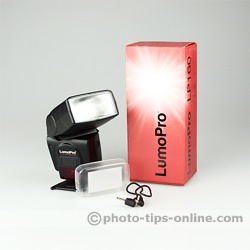 |
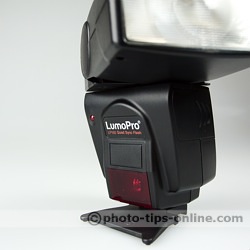 |
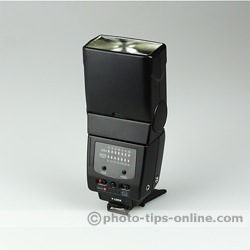 |
Being a manual flash, LumoPro LP160 has a single-pin foot to be used in a hot shoe of any photo system, including Canon, Nikon, Pentax, etc.
Free from proprietary TTL technologies (like E-TTL, i-TTL, P-TTL, etc.), LP160 can be triggered optically. The optical wireless triggering can be done in two modes: "S" (optical slave) and "Si" (digital optical slave).
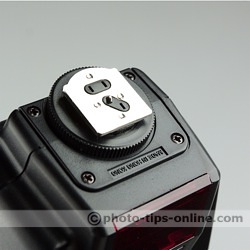 |
In the "S" mode, the flash simply fires when it detects a burst of light. It is common for optical triggering and works very well when your master flash is in manual mode. LumoPro LP160 is extremely sensitive and works great in situations when other optical slaves may fail.
When you want to use the modern TTL modes of your master flash unit, you typically run into problems with optical triggering. In a TTL mode, master flash usually does a pre-flash prior to the flash burst that is actually captured by the camera. The optical slaves fire with the pre-flash and usually miss the main flash busrt since it follows almost immediately. So, to enable users to utilize TTL, LumoPro offers the "Si" slave mode, in which the pre-flash is ignored. It is, of course, not equivalent to using a TTL slave, since you have to set the power of LP160 manually.
Please note, since LP160 does not fire during pre-flash time, its output is not included in the TTL calculation, and you may need to adjust the power of your master unit to get the correct exposure. Thus, if you use LumoPro LP160 as a main or fill light, it is probably not worth it to shoot in TTL. In this case, manual mode will be easier to handle. However, if you're lighting your background with LP160 or using this flash as a hair or even edge light, the "Si" mode can be very useful.
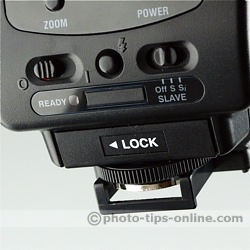 |
Another way to trigger LumoPro LP160 is by using a cord. The flash supports miniphone (3.5mm) and PC connections (miniphone-to-PC cord is included).
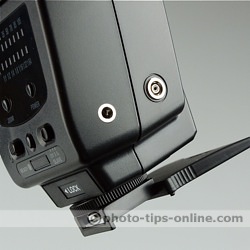 |
Flash head of LP160 is a bit wider than you usually see on flashes (compare to Canon Speedlite 580EX II below). The flash does not have a built-in wide angle panel or a catchlight card, but it does come with a separate wide angle adapter that snaps on for a wider frame coverage.
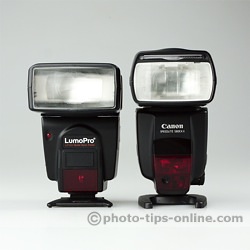 |
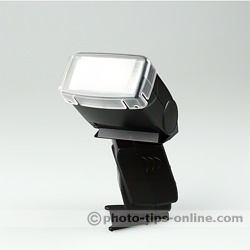 |
The head tilts from -7 to 90 degrees and rotates from -150 to 180 degrees (330 total, so you only miss 30 degrees out of the full 360 range). This gives you plenty of options for bouncing your flash light.
There is no button to be pushed to rotate or tilt the flash head. You simply turn the head from any position to a new one, which is easy and convenient.
 |
The flash is controlled by two buttons: power and zoom. Pushing a button cycles through the power values or zoom positions, respectively. Thus, there is no way, for example, to go from 35mm zoom position to 24mm other than going all the way to the highest value and then returning back to 24mm. Having additional buttons to be able to go in both directions would be a nice improvement, but we don't see this as a big issue since the number of options is limited, and it does not take long to set the values you want.
The power and slave mode switches are two- and three-way, respectively. Creating a good usable three-way switch is often a challenge, but we find the slave switch works reasonably well in this case.
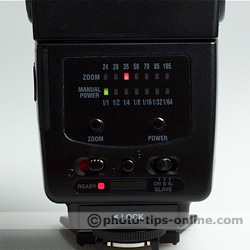 |
After 30 minutes of inactivity, LumoPro LP160 goes into stand-by mode to save the power of your batteries. To wake it up, you can press the test button, which turns the flash on (the test button does not cause the flash to fire in this case). Alternatively, you can turn the unit off and back on, but be aware that in this case, all your settings will be reset to the default initial state: 35mm zoom and full power. So, if you want to keep your settings after the flash is back from the stand-by mode, we don't recommend using the power switch. The third option is to fire a master unit which will also bring LP160 back from stand-by.
LumoPro LP160 is a powerful flash unit. We conducted a quick test to see how it compares to one of the top flashguns on the market today. Images below show exposures from Canon Speedlite 580EX II (left) and LumoPro LP160 (right) at full power (identical camera setting, 105mm flash zoom).
 |
 |
You can see that the image from LumoPro flash is a bit darker, but the exposures are close. It appears that the difference in output is about half a stop in this case.
The recycling of LP160 is not silent. So, you can hear the capacitor making high-pitched sound during recycling.
When changing the batteries, the battery compartment door has to be fully detached, which makes it possible to drop or even lose it. However, with a little caution, it is not a problem.
LumoPro LP160 features two ready indicators on back and front sides, which makes it very convenient to use the flash as a slave since you can see the readiness state from two sides rather than just from one.
A small flash stand is included with LP160, which allows to set it up on a flat surface.
The mounting foot of LP160 is metal, and it is more durable than the plastic ones used in the past.
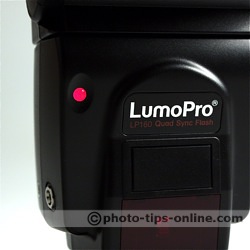 |
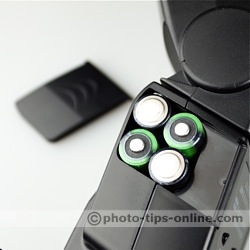 |
| Guide number (at ISO 100): | 140 feet |
| Minimum Recycling Time, Full power: | 4 seconds with AA Ni-MH |
| Remote function: | Optical Slave, Digital Optical Slave, PC syncro port, miniphone (3.5mm) port |
| Power settings: | Full, 1/2, 1/4, 1/8, 1/16, 1/32, 1/64 |
| Zoom Settings: | 24, 28, 35, 50, 70, 85, 105mm |
| Swivel: | 330 degrees |
| Tilt: | From -7 to 90 degrees |
LumoPro LP160 is a well-built flash unit with a lot of power nearly matching the top flash units from Canon and Nikon. It delivers many triggering options including the miniphone and PC connectivity, as well as the optical and digital optical wireless triggering. LP160 can be a great choice for a slave unit in a manual or TTL setup. It also works great as an on camera manual flash unit.